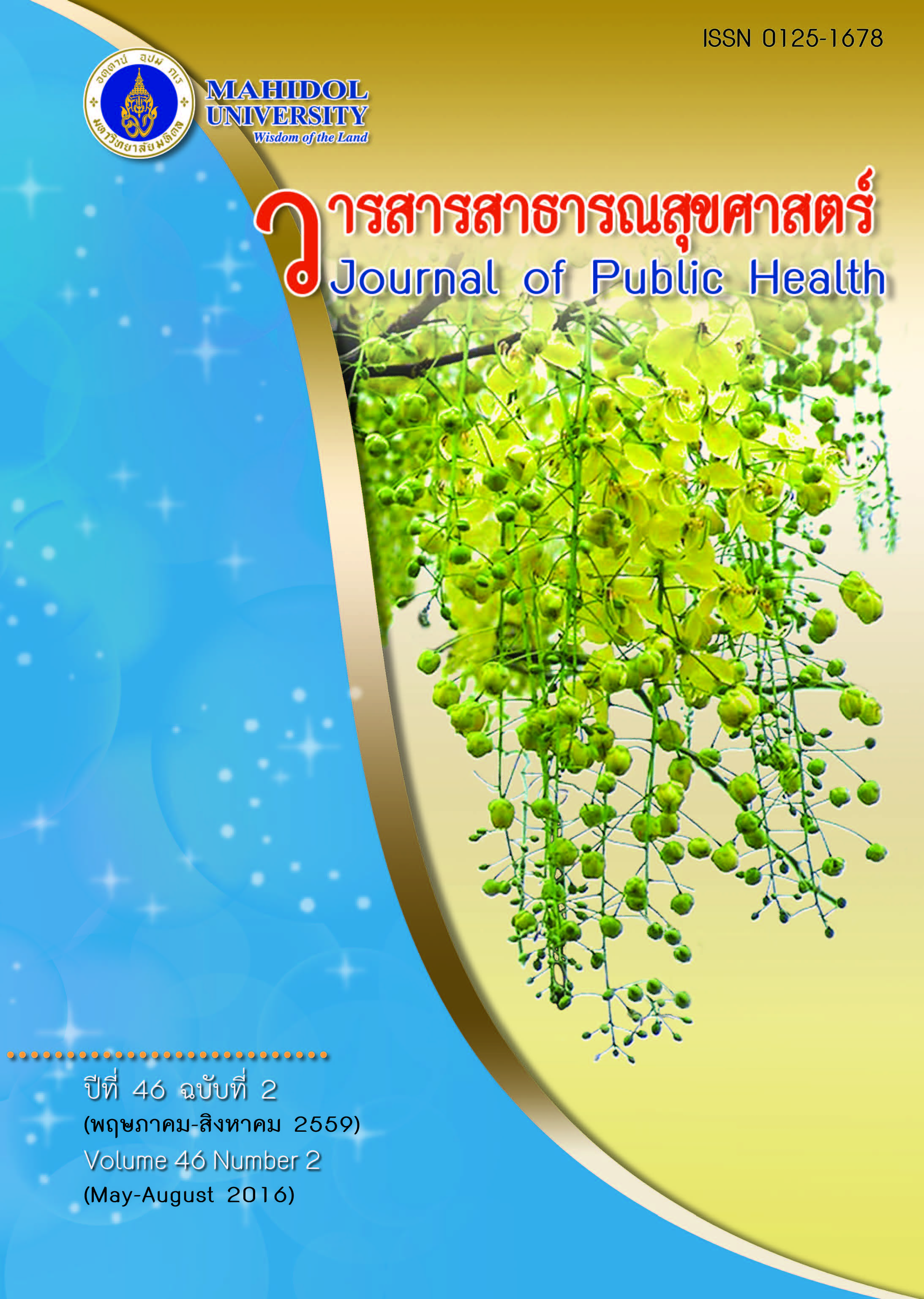ผลของโปรแกรมส่งเสริมการบริหารข้อเข่าด้วยท่าฤๅษีดัดตนเพื่อบรรเทาอาการปวดในผู้ป่วยโรคข้อเข่าเสื่อม
Keywords:
รูปแบบการให้ข้อมูลข่าวสาร การสร้างแรงจูงใจและการพัฒนาทักษะ, ท่าฤๅษีดัดตน, โรคข้อเข่าเสื่อม, information motivation and behavioral skills model, “Rue Si Dat Ton”, knee osteoarthritisAbstract
บทคัดย่อ
โรคข้อเข่าเสื่อมเป็นปัญหาสุขภาพที่สำคัญ การศึกษานี้มุ่งพัฒนาโปรแกรมส่งเสริมการบริหารข้อเข่าด้วยท่าฤๅษีดัดตนเพื่อบรรเทาปวดในผู้ป่วยโรคข้อเข่าเสื่อม โดยประยุกต์มาจากแนวคิด IMB มีชื่อว่า “SMART OA” (S: ความรู้จำเพาะ, M: ตั้งเป้าหมาย, A: สร้างเจตคติ, R: แรงจูงใจทางสังคม, T: ฝึกปฏิบัติจนชำนาญ, OA: โรคข้อเข่าเสื่อม) เป็นการวิจัยกึ่งทดลอง แบบสองกลุ่มชนิดวัดก่อนและหลังในผู้ป่วยโรคข้อเข่าเสื่อม ณ ศูนย์แพทย์ปฐมภูมิฯ ม.ธรรมศาสตร์ กลุ่มละ 23 คน กิจกรรมมีด้วยกัน 3 ครั้ง และโทรศัพท์ 4 ครั้ง ระยะเวลา 8 สัปดาห์ ประกอบด้วย ครั้งที่ 1 การให้ความรู้ สร้างเจตคติ และฝึกทักษะ ครั้งที่ 2 แลกเปลี่ยนประสบการณ์ และพัฒนาทักษะ ครั้งที่ 3 ทบทวนกิจกรรม และสัปดาห์ที่ 2, 4, 6 และ 8 ติดตาม กระตุ้นให้มีแรงจูงใจ ทางโทรศัพท์ เก็บข้อมูลโดยใช้แบบสัมภาษณ์และแบบสังเกต วิเคราะห์ข้อมูลด้วยสถิติร้อยละ ค่าเฉลี่ย Chi-square, Paired T-Test, และ Independent T-Test พบว่า ภายหลังการทดลอง กลุ่มทดลองมีคะแนนเฉลี่ยด้านความรู้ เจตคติ ทักษะ และการปฏิบัติการบริหารข้อเข่าฯ มากกว่าก่อนการทดลอง และมากกว่ากลุ่มเปรียบเทียบอย่างมีนัยสำคัญทางสถิติ (p<0.001) ส่วนคะแนนเฉลี่ยการปวดของเข่าลดลงกว่าก่อนการทดลอง (p<0.001) และลดลงกว่ากลุ่มเปรียบเทียบอย่างมีนัยสำคัญทางสถิติ (p = 0.003) ดังนั้นโปรแกรมสามารถบรรเทาปวดในผู้ป่วยโรคข้อเข่าเสื่อมได้
The Effects of Knee Exercise Promotion Program with “Rue Si Dat Ton” for Knee Pain Relief among Osteoarthritis Patients
ABSTRACT
Currently, knee osteoarthritis (OA) poses an important problem. This research aimed to develop an exercise promoting program with, “Rue Si Dat Ton”, for knee pain relief among knee OA patients. In addition, the IMB model was employed to design a health education program, ‘SMART OA’ (S: Specific Knowledge; M: Monitor Your Progress; A: Attitude; R: Recruit Social Motivation; T: Treat Yourself; OA: Osteoarthritis). The research employed a quasi-experimental design with two groups conducting pre- and posttests implemented for knee OA patients in the Primary Care Center, Thammasat University. The experimental and comparative groups totaled 23 subjects each. Activities were conducted 3 times and phoned 4 times over 8 weeks. The first activity aimed to provide knowledge, create attitude and develop skills of knee exercise using Rue Si Dat Ton. The second activity targeted sharing experiences, raising motivation and developing skills while the third activity shared experiences and reviewed previous activities. At weeks 2, 4, 6 and 8 subjects were followed up by phone to stimulate and motivate knee exercise. Data were collected by interview and observation checklist and were analyzed by analytical statistics, paired t-test and independent t-test to compare mean within and between groups. The results indicated that after attending the program, significant improvement were observed in the experimental group in terms of knowledge, attitude, exercise skills and knee exercise practice (p<0.001). Knee OA patients in the experimental group reduced knee pain significantly when compared between before and after participating in the SMART OA program within the group (p<0.001) and compared with the control group (p = 0.003). Appropriate exercise relieved knee pain of OA patients.
Downloads
Published
Issue
Section
License
Creative Commons License CC-BY-ND


